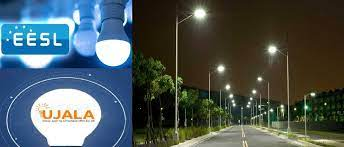UJALA and SLNP programmes

Copyright infringement is not intended
Context: The Ministry of Power has released a report on UJALA and SLNP programmes.
About UJALA and SLNP programmes
- The Union Ministry of Power launched the Unnat Jyoti by Affordable Light Emitting Diode (LED) for All (UJALA) in January, 2015 to provide energy efficient LED bulbs to domestic consumers at an affordable price.
- The programme was successful in bringing down the retail price of the LED bulbs from Rs. 300- 350 per LED bulb in the year 2014 to Rs 70-80 per bulb, in a short span of 3 years.
- The Union Ministry of Power launched the Street Lighting National Program (SLNP) in January 2015 as “Prakash Path”; National Program for adoption of LED Street Lighting.
- The main objective was to convert conventional Street Lights with energy efficient LED Street Lights.
- Energy Efficiency Services Limited (EESL) was designated as the implementing agency to implement this program across Pan-India.
- EESL joined hands with the Urban Local Bodies (ULBs), Municipal Bodies, Gram Panchayats (GPs) and Central & State Governments to implement SLNP across India.
Key Features of the UJALA programme
- Increase the demand of LED lights by aggregating requirements across the country and providing economies of scale to manufacturers through regular bulk procurement, which helped the manufacturers to reduce the cost of LED bulbs not only for the UJALA program but for the retail segment as well.
- Promote the use of the most efficient lighting technology at affordable rates to domestic consumers which benefits them by way of reduced energy bill while at the same time improving their quality of life through better illumination.
- Enhance consumer awareness on the financial and environmental benefits of using energy efficient appliances, thus creating a market for energy efficient appliances.
Key Features of Street Light National Programme
- Reduction in Energy Consumption: Reduce energy consumption in lighting which helps DISCOMs to manage peak demand.
- Market Transformation by reduced pricing through demand aggregation and Shift the buying preference from Sodium Vapour/Fluorescent Lighting to LED Based Solid State Lighting.
- Promote Energy Service Company (ESCO) model Approach: Under this model, ESCO replaces the conventional street lights with LEDs at its own costs (without any need for municipalities to invest) and the consequent reduction in energy and maintenance cost of the municipality is used to repay ESCO over a period of time.
- GreenHouse Gas (GHG) Emission Reduction: Mitigate climate change by implementing energy efficient LED based street lights resulting in reduced GHG emissions. Also, reduction in energy intensity thereby supporting India’s Nationally Determined Contribution (NDC) goals.
- Improvement in the safety and security in public areas in rural, semi urban, and urban settings through better illumination.
Present Status
- Under UJALA programmes
- Distribution of 36.79 Crore (as on 16.03.2022) LED bulbs.
- This resulted in energy saving of 47,784 million units of electricity per annum, and 38.70 million tonnes of CO2 emission reduction annually.
- Under SLNP programmes
- Till date, EESL has installed over 1.23 crore (as on 16.03.2022) LED street lights in ULBs and Gram Panchayats across India.
- This has resulted in Energy Saving of 8516.7 Million Unit of Electricity per annum, and 5.87 Million tons of CO2 emission reduction annually.
Way Forward
- These schemes initiated a market transformation in the field of energy efficiency.
- It helped citizens to save money on their electricity bills (a 15% reduction in average household electricity bills), while also providing better lighting in their homes.
- The money saved contributes towards a family's discretionary income and long-term investments and thereby, enhances their quality of life and creates wealth in their communities.
- The Government is actively introducing initiatives to move further on the path to transform illumination and energy efficiency in the country. For example, EESL has an ambitious strategy, under the Street Lighting National Programme (SLNP), it plans to attract investments worth Rs. 8,000 crore (US$ 1.09 billion) by 2024 by covering the entire rural India.



1.png)
